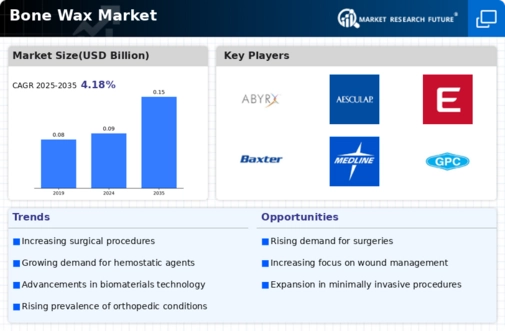Market Trends
Introduction
The Bone Wax Market is poised to experience a major growth spurt as a result of a confluence of the most recent technological developments, upcoming regulations and changes in the way consumers are shopping. In the sphere of biomaterials, the development of biocompatible materials and the introduction of new surgical techniques are reshaping the product portfolio, while stringent regulatory guidelines are driving manufacturers to focus on safety and efficacy. In addition, the rising awareness among both healthcare professionals and patients regarding the importance of hemostatic solutions is influencing purchasing decisions. These trends are strategically important for the industry’s key players, as they not only dictate the competitive positioning of products but also highlight the need for agility in a rapidly changing healthcare landscape.
Top Trends
-
Increased Surgical Procedures
Elective surgery, particularly orthopaedic surgery, has led to an increase in demand for bone wax. For example, in the last year the American Academy of Orthopaedic Surgeons reported a 15 per cent increase in the number of joint replacements. This has meant that manufacturers have had to increase production capacity in order to ensure a steady supply of bone wax. As surgical activity increases, the bone wax market is expected to expand as well, with new formulations to meet the diverse needs of surgeons. -
Technological Advancements in Bone Wax
Developments in bone wax formulations, such as the development of bioresorbable bone waxes, are also gaining in popularity. Ethicon, Inc. is investing in R & D to develop products that can minimize complications. A recent study has shown that bioresorbable bone waxes can reduce the risk of infection by 20 percent. This trend will lead to better patient outcomes and increased demand for bone waxes from hospitals looking for safer alternatives. -
Regulatory Changes and Compliance
The bone wax market is regulated by stricter regulatory frameworks, and regulatory agencies such as the FDA have been increasing their scrutiny of medical devices. These new guidelines are essential for market participants to comply with, as non-compliance can result in product recalls. This trend has increased the need for quality assurance, which increases operational costs but ultimately leads to increased product reliability and safety. -
Rising Awareness of Surgical Site Infections
The growing concern about surgical site infections has led many hospitals to use advanced bone wax products. Research has shown that surgical site infections can increase hospital stays by an average of seven days, leading to higher costs. Therefore, hospitals are placing a high priority on using effective bone wax to reduce the risk of surgical site infections, which has affected the purchase behavior of hospitals and the market. -
Shift Towards Minimally Invasive Techniques
The trend towards minimally invasive surgical procedures is changing the market for bone waxes. These procedures often require specialized products. A recent report highlighted the fact that the number of minimally invasive procedures has increased by 30% in the past year. This trend is encouraging manufacturers to develop bone waxes that are compatible with these procedures. This could enable them to gain access to new markets and increase the quality of their products. -
Focus on Customization and Personalization
There is a growing demand for bone waxes adapted to the special requirements of surgical practice. The companies have exploited the 3D-printing technology to produce individualized products which can improve surgical results. A survey has shown that over sixty-five percent of surgeons prefer individualized solutions for complex cases. This trend is likely to bring about a greater collaboration between the manufacturers and the health care industry. -
Sustainability Initiatives in Production
The production of bone wax is now a matter of great interest to firms, which are making an effort to use natural materials. Baxter International, for example, has started a programme to reduce the amount of waste plastic from its manufacturing process. This is not only a way of meeting official requirements, but it also appeals to consumers, who are becoming more and more aware of the environment, and may enhance a company’s brand loyalty and market position. -
Expansion in Emerging Markets
The bone wax industry is growing fast, thanks to the increasing number of hospitals and the growing health care budgets in the emerging economies. India and Brazil are expanding their medical care, and the number of surgical operations is expected to increase by 25 percent by the year 2025. This trend offers opportunities for the major market players to enter the emerging markets, thereby increasing their market share and diversifying their revenue streams. -
Integration of Digital Health Solutions
The digitalization of medical technology has an impact on the bone wax market. Telemedicine and surgical planning software are used to optimize surgical procedures. A study showed that digital tools can increase surgical efficiency by 15 percent. This trend is likely to encourage manufacturers to cooperate with IT companies, thereby fostering innovation and accelerating product development. -
Increased Competition and Market Consolidation
Competition in the bone wax market is increasing, resulting in the possibility of a merger between the major players. The common denominator in these combinations is the desire to increase product range and market share. These combinations may result in a more consolidated market, with fewer but stronger players, which will ultimately affect the price policy and the availability of products.
Conclusion: Navigating the Bone Wax Market Landscape
The Bone Wax Market is characterized by a high degree of competition and high fragmentation. The market is shared by both established and new players. The Bone Wax Market is growing in North America and Europe, driven by advances in surgical techniques and increased focus on patient outcomes. Suppliers are strategically positioning themselves by utilizing artificial intelligence for enhanced product development, automation for efficient manufacturing processes, and sustainability to meet regulatory requirements and consumers’ preferences. Product differentiation is expected to be a key success factor, as healthcare professionals seek tailored solutions. Strategic leaders will have to focus on these three areas to maintain their position in the evolving market.









Leave a Comment